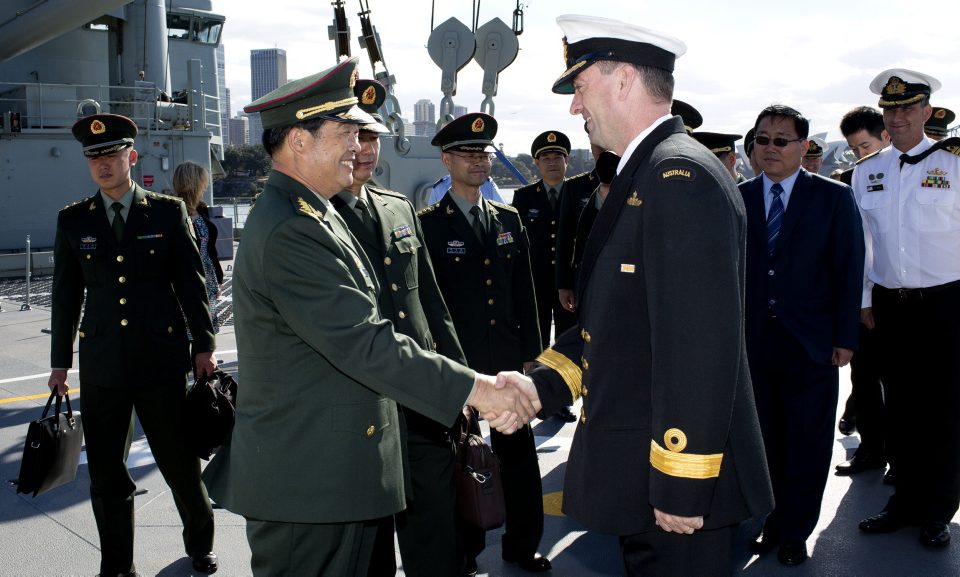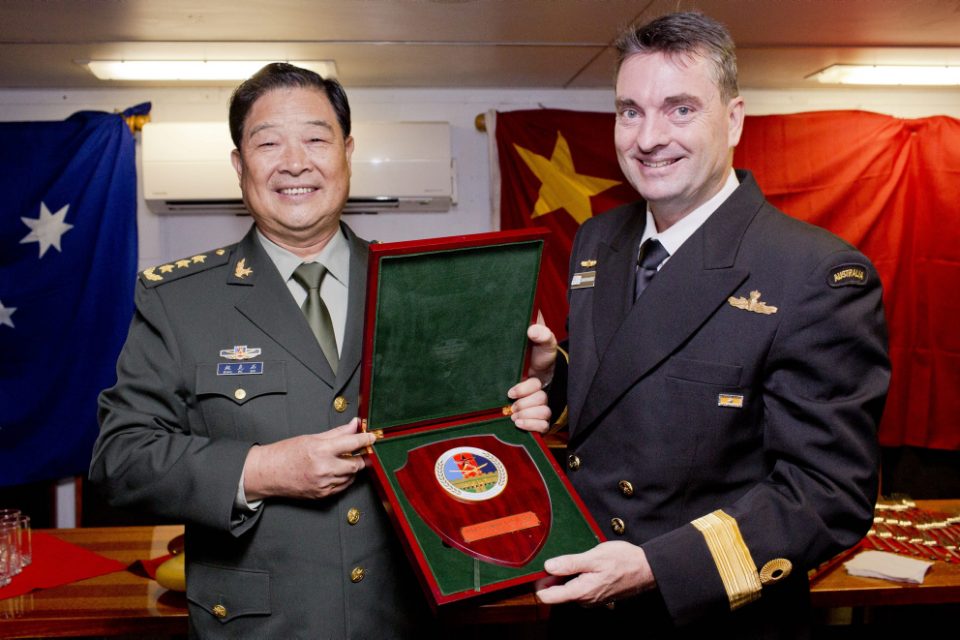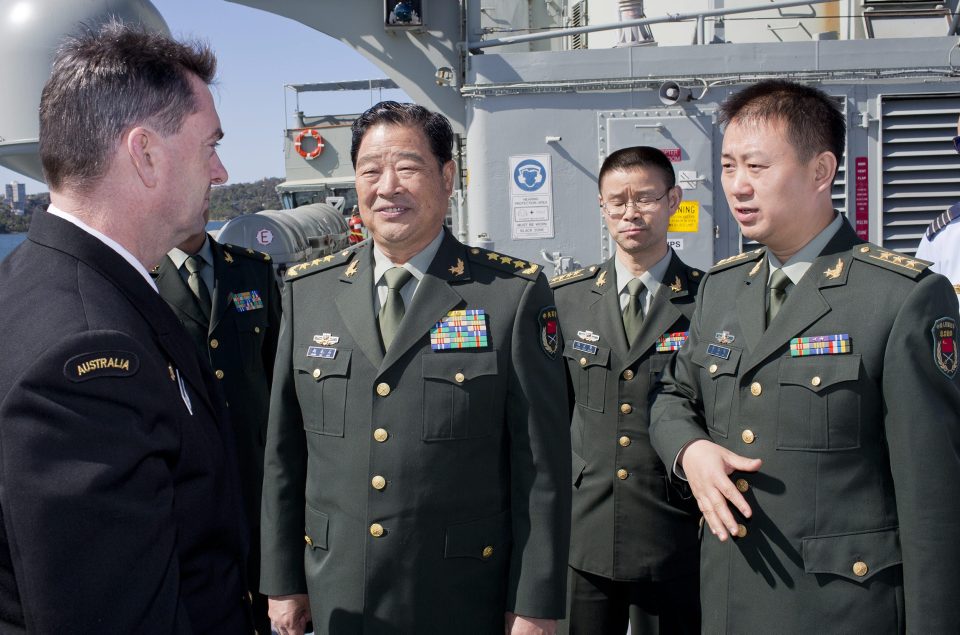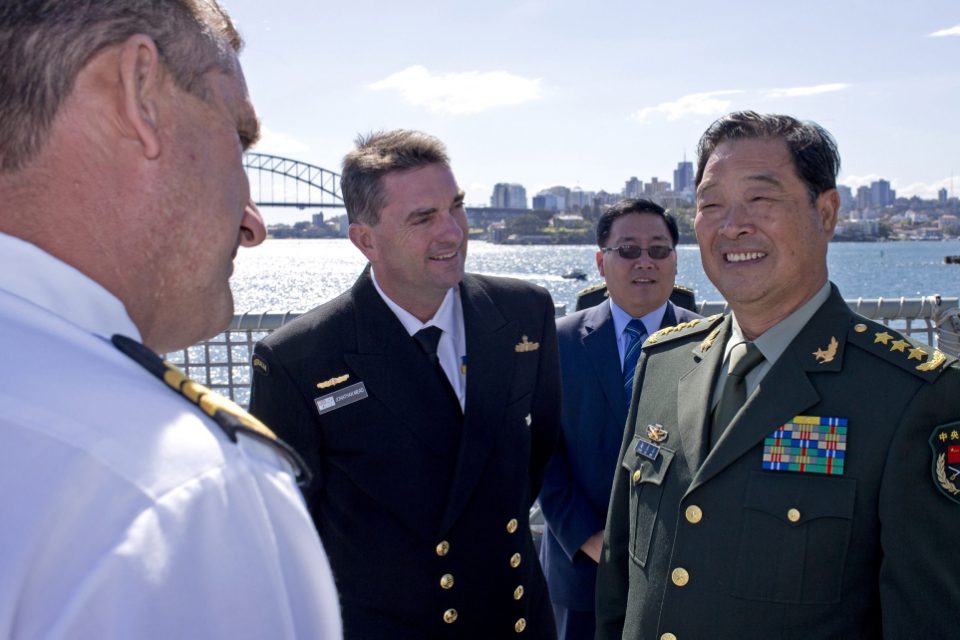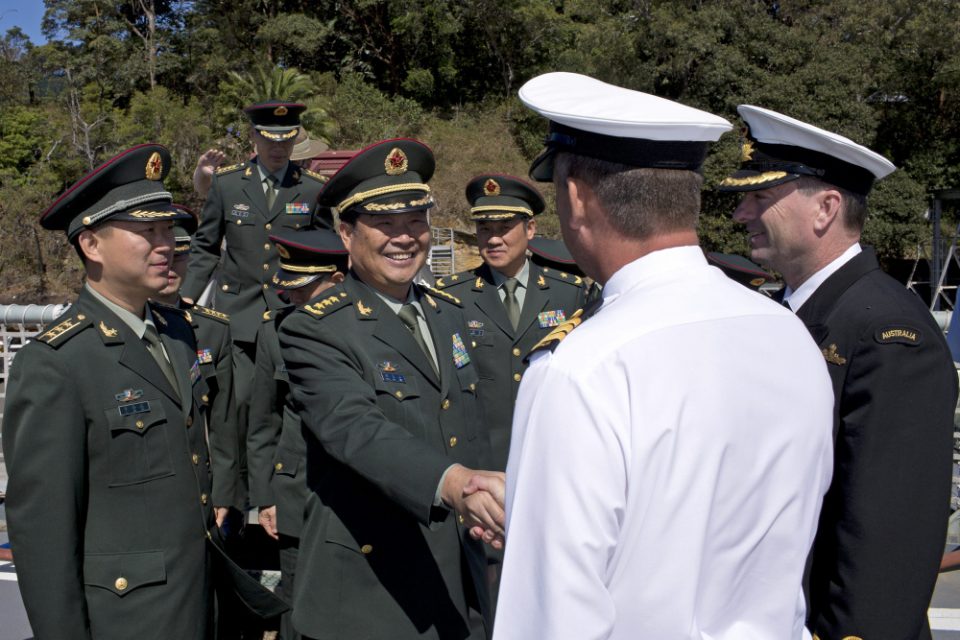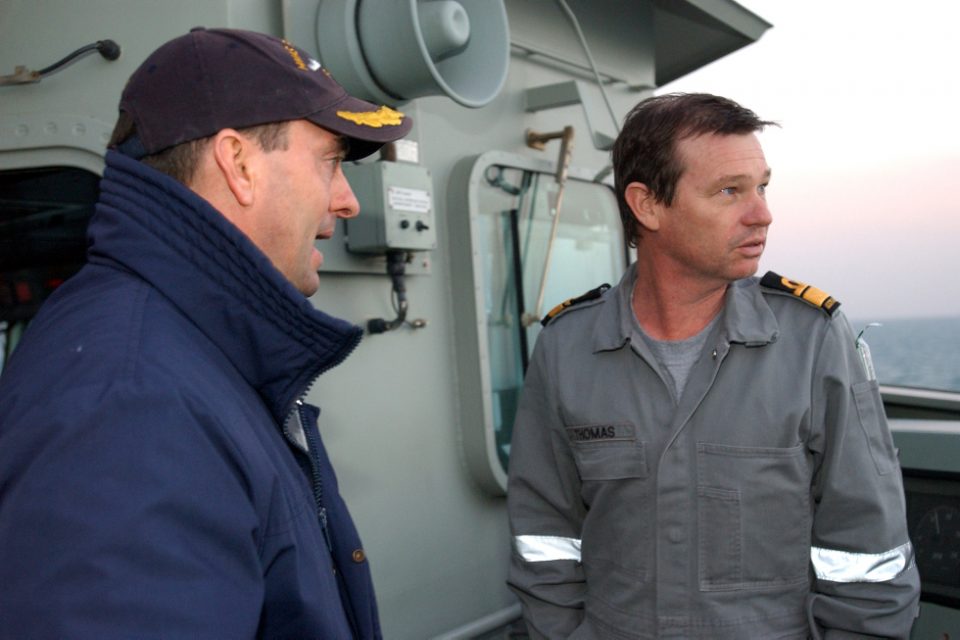2016-08-30 By Robbin Laird
Prior to attending the Williams Foundation Seminar on air-sea integration, I had the opportunity to sit down with Rear Admiral Johnathan Mead in his office in Canberra to discuss his perspective, on the way ahead with regard to the Navy within the evolution of the ADF.
Rear Admiral Mead is the Navy’s joint capability manager and is clearly focused on the cross-cutting dynamics of maritime modernization within the context of the overall evolution of the ADF.
Although the Head of Navy Capability since 2015, Rear Admiral Mead is part of the transition set in motion since April 1, 2016 to shaping a new approach to shaping joint force capability. As he put it:
“The way the department was structured previously was capability development was centralized in a group led by joint three-star.
“One of the recommendations of The First Principles report was to bring those accountabilities from the center back out to Navy, Army, Air Force.
“Whereas previously the services had de facto a third party working it for them, now as of the first of April, it’s all come back directly to the services.
“The Chief of Navy is accountable for all naval capability across the board from building to life cycle support to disposal of assets.
“We’re only about five months in that transition.
“The services led by the Vice Chief, is now accountable for the investment program and also for the force design and bringing the alignment capabilities of the three services together into a joint force.
“That’s where we are today.”
With the launching of the White Paper, a significant modernization of the ADF was put in motion with a major build for the Australian Navy, including new submarines, air warfare destroyers and frigates.
This build will unfold within the evolving context of the overall transformation of the Australian Defence Force, which highlights shaping an integrated force able to operate in the extended battlespace.
Question: A key element of the rethink clearly is with regard to how you are thinking about the new assets in terms of task force operations.
Could you discuss the new amphibious ships from this perspective?
Rear Admiral Mead: “The ship itself provides the government an enormous array of options and flexibility, but we have no intention of deploying the ship by itself. Our philosophy is to deploy in task groups, but in a flexible manner.
“The amphibious ships are clearly going to anchor any amphibious task force, but those task forces will employ a mix and match capability of air, land and sea assets.
“And we are looking beyond a classic understanding of an amphibious task force role for these ships, for they could operate as C2 ships in an ASW effort with embarked helos on board, and integrated with the P-8s, Tritons and other assets as well.

“And that will be true of how we will use the new air warfare destroyers as well, providing C2 and support capabilities for integrated air-land-sea missile defense or be the lead in such an effort.”
Question: As you build the new submarine and its combat system, clearly there is an interest for that submarine to tap into the information network which the ASW force can provide for it, such as the P-8/Triton dyad might provide.
How do you view that process?
Rear Admiral Mead: “Obviously, the silent service wishes to operate in such a manner that two-way communication does not compromise its operations.
“But equally obvious, is that the new submarines will operate in such a manner that they can tap into the evolving ASW network and have its combat systems benefit from that data input to maximize its mission success.
“The new submarines and their combat systems will clearly be designed effectively.to tap into the maritime warfare network.
“The task will be moving that information around so it won’t duplicate and so there’s no gaps in the coverage.”
Question: How do you bring coherency to the diverse programs you are managing?
Rear Admiral Mead: “It is clearly a challenge.
“In my front hallway, there is a large diagram — it’s about three meters in length and about one half meters wide — and it articulates all the major capability programs we’ve got on the way now and how they’re connected.
“My job is to try and bring a sense of coherency to that program. I do drill down to individual projects and some have very short timelines.
“But in the main, we are adopting a programmatic approach to navy capability.
“We are looking to maximize efficiencies and to work effectively in partnership with industry to do so. It is a challenge.”
Question: When I visited Williamtown, I was impressed to see the System Program Office located next to the squadron so that that software developers could work directly with the squadron on shaping a way ahead.
I understand the Navy has something similar in mind.
Could you talk to that approach?
Rear Admiral Mead: “We do and we call it the “Ship Zero” approach.
“As we build our new ships, we are going to do so around a common structure, which brings together the sustainment, the training, command and management, land-based test bed, simulation the software development and importantly industry, into a common facility in order to provide the horsepower and genius necessary to support the capability at sea..
“We are trying to bring all the key elements into a building wherein that building is located close to where the platforms we’ll be operating from.
“This is a new concept for us.
“It’s about shaping an approach to proper asset management, maximizing the capability the ships can get through 30 to 40 year life.”
Biography of Rear Admiral Mead
Rear Admiral Jonathan Mead, AM, RAN joined the Royal Australian Navy in 1984 and proceeded to sea in 1986. He specialised in Mine Clearance Diving and Explosive Ordnance Disposal and after serving as Executive Officer of Clearance Diving Team One he undertook Principal Warfare Officer (ASW) training. A succession of warfare postings then followed, including: Anti Submarine Warfare Officer in HMAS Melbourne and HMAS Arunta, Fleet Anti-Submarine Warfare Officer and Executive Officer of HMAS Arunta.
In 2005, he commanded HMAS Parramatta and saw active service in the North Arabian Gulf as part of Operation CATALYST; for this his ship was awarded a Meritorious Unit Citation and he was appointed a Member of the Order of Australia.
He undertook studies at the Indian National Defence College in 2007 after which he assumed the appointment as Australia’s Defence Adviser to India.
Promoted to Commodore in July 2011, Commodore Mead deployed to the Middle East where he commanded Combined Task Force 150, responsible for maritime counter terrorism. Upon his return to Fleet Headquarters in 2012, he served as Commander Surface Force. In January 2015, he was promoted to Rear Admiral and assumed the position as Head Navy Capability.
Rear Admiral Mead holds a Masters Degree in International Relations, a Master’s Degree in Management and a PhD in International Relations. He has published a book on Indian national security.
The slideshow above shows Rear Admiral Mead earlier in his career.
These photos highlight a visit by General Zhao Keshi, Chief of Central Military Commission of People’s Republic of China, Chief of the General Logistics Department, People’s Liberation Army on HMAS Tobruk at Sydney’s Garden Island naval base when then Commodore Jonathan Mead was the Commander Surface Force.
Also shown is then Commander Jonathan Mead when he was captain of HMAS Parramatta on the bridge of the frigate with the Maritime Commander Australia, Rear Admiral Davyd Thomas, in the Persian Gulf
What exactly does the 2016 White Paper say with regard to Government commitments to new maritime capabilties?
The following is taken from the 2016 Defence White Paper with regard to the general discussion on the way ahead with regard to maritime capabilities:
Highly capable and versatile naval and maritime forces are vital to our defence strategy.
Australia’s naval and maritime forces must be able to undertake a wide range of activities in support of the Strategic Defence Objectives and operate across huge distances.
The area of Australia’s maritime zones, including our Exclusive Economic Zone, is one of the largest in the world, with a total marine area of around 10 million square kilometres.
Australia is also responsible for covering one of the largest search and rescue areas in the world, some 53 million square kilometres of the Indian, Pacific and Southern Oceans.
Our naval and maritime forces deploy around the world for training, exercises and to participate in coalition operations to support the rules-based global order.
Modernising our maritime capabilities will be a key focus for Defence over the next 20 to 30 years.
Our maritime forces will become more potent through the acquisition of more capable submarines, ships and aircraft and better integration of combat and supporting systems across Defence. These forces will help to protect our maritime borders, secure our immediate northern approaches and proximate sea lines of communication and enable us to project force in the maritime environment Increasingly, these capabilities will provide an ability to undertake anti-submarine warfare throughout the maritime environment.
Defence’s ability to contribute to border protection will be enhanced with the introduction of larger, more capable offshore patrol vessels with greater range, endurance and improved carrying capacity and a new large-hulled multi-purpose patrol vessel, the Australian Defence Vessel Ocean Protector.
The Government will invest in enhancements to multiple layers of the maritime surveillance system including new manned and unmanned aircraft.
Submarines
Submarines are an essential part of Australia’s naval capability, providing a strategic advantage in terms of surveillance and protection of our maritime approaches.
The Government has determined that regionally superior submarines with a high degree of interoperability with the United States are required to provide Australia with an effective deterrent, including by making a meaningful contribution to anti-submarine warfare operations in our region.
The key capabilities of the future submarine will include: anti-submarine warfare; anti-surface warfare; intelligence, surveillance and reconnaissance; and support to special operations.
The Government will increase the size of the submarine force from six to 12 boats. The doubling in size of the submarine fleet recognisesthat Australia will face a more challenging maritime environment in the decades ahead.
By 2035, around half of the world’s submarines will be operating in the Indo-Pacific region where Australia’s interests are most engaged. Australia has one of the largest maritime domains in the world and we need the capacity to defend and further our interests from the Pacific to the Indian Oceans and from the areas to our north to the Southern Ocean. Submarines are a powerful instrument for deterring conflict and a potent weapon should conflict occur.
Australia’s new submarines will be supported by upgrades to enablers and facilities such as wharves and port facilities, as well as simulators, training and submarine rescue systems. The key strategic requirements for the future submarines include a range and endurance similar to the Collins Class submarine, sensor performance and stealth characteristics which are superior to the Collins Class, and upgraded versions of the AN/BYG-1 combat system and Mark 48 MOD 7 heavyweight torpedo jointly developed between the United States and Australia as the preferred combat system and main armament. The new submarines will have advanced communications systems to link with other Navy ships and aircraft to conduct anti-submarine warfare operations.
The acquisition of the 12 future submarines will commence in 2016 with the first submarines likely to begin entering service in the early 2030s. Construction of the 12 new submarines will extend into the late 2040s to 2050 timeframe. The length of the construction process will mean that Australia will need to be planning the follow-on submarine well before the last new submarine enters service.
To ensure no capability gap and the ability to progress development of a replacement submarine in the 2050s, the Government has decided to implement a rolling acquisition program for Australia’s submarine fleet. A rolling acquisition program will ensure that Australia is able to maintain a fleet of 12 regionally superior submarines as submarine and anti-submarine technologies develop over the coming decades.
During the long life of the new submarines, the rapid rate of technological change and ongoing evolution of Australia’s strategic circumstances will continue. As part of the rolling acquisition program, a review based on strategic circumstances at the time, and developments in submarine technology, will be conducted in the late 2020s to consider whether the configuration of the submarines remains suitable or whether consideration of other specifications should commence.
The future submarine program is the largest defence procurement program in Australia’s history. The Government has already committed to maximising Australian industry involvemen in the submarine program, without compromising cost, capability, schedule or risk. The Government will announce the results of a Competitive Evaluation Process in 2016
The Government will also continue to make appropriate investments in the existing Collins Class fleet, including priority capability enhancements, obsolescence management and fleet sustainment, to ensure Australia’s potent and agile submarine capability is maintained until the introduction of the future submarine fleet. This will include upgrades to the Collins Class communications and sensor capabilities.
This investment will build on recent improvements to Collins Class availability In 2011–12, Collins Class availability was about half that of the international benchmark and in the past there had been up to three submarines undergoing long-term maintenance. Following the 2012 Coles Review and implementation of a comprehensive and innovative transformation plan, there has been a major improvement in the availability of the Collins Class, and Defence is on track to reach the international benchmark for submarine availability by mid-2016.
By mid-2016, the submarine HMAS Farncomb will have completed the first two-year full cycle docking in Adelaide – a maintenance activity that formerly took over three years to complete. From then onwards only one Collins Class submarine will be in Adelaide for full cycle docking Defence will continue to work closely with industry to implement reforms to optimise Collins Class availability, reliability and capability.
Surface Vessels
Surface vessels will continue to play a critical role in protecting our sovereignty, maintaining presence and projecting force into the region and beyond. They are an important component of our joint force and will operate as a highly integrated part of our force with enhanced situational awareness, communications and data sharing between maritime, air and land-based systems.
Our surface vessels must be capable of independent Australian operations, as well as operating in coalition taskforces They must also contribute to a wide range of whole-of-government priorities, including border security, search and rescue, and humanitarian assistance and disaster relief operations.
Key elements of new naval capability will include 12 major surface vessels. The three Hobart Class Air Warfare Destroyers to enter into service in the early 2020s will provide Australian or coalition maritime task groups with defence against air and missile attack. The Hobart Class will be equipped with new advanced surface to air missiles to enter service by the middle of the next decade. Nine new future frigates optimised for anti-submarine warfare will be introduced into service from the late 2020s to replace the existing fleet of eight Anzac Class frigates, with construction to start in 2020.
The Government will acquire 12 new offshore patrol vessels that will provide greater reach and endurance than the existing Armidale Class patrol boat fleet. The new vessels will be capable of undertaking several different roles including enhanced border protection and patrol missions over greater distances than is currently possible with the existing patrol boat fleet, with construction to start in 2018. All 12 offshore patrol vessels will be delivered by 2030 The Armidale Class will be supplemented by additional patrol craft as required until they are replaced by the offshore patrol vessels, to ensure there is no gap in Navy’s border protection capability.
The mine countermeasures and military hydrography capability will be updated to support the future force. The life of four of the current Huon Class mine hunters will be extended while new technologies are developed to counter the threat of maritime mines Defence will seek to replace the hydrographic capability with an efficient combination of military and commercial hydrographic and oceanographic survey capabilities.
Capability priorities
Eight P-8A Poseidon maritime surveillance and response aircraft will be introduced in the early 2020s, with seven additional aircraft to be acquired in two tranches to bring the total to 15 aircraft by the late 2020s. These aircraft have a range of over 7,500 kilometres, and can be refuelled in the air by Australia’s KC-30A air-to-air refuelling aircraft, extending their range even further In addition to being able to undertake sophisticated surveillance operations at great distances, the P-8A can undertake offensive operations against submarines and ships, as well as supporting search and rescue operations.
To complement the surveillance capabilities of the Poseidon, the Government will acquire seven high altitude MQ-4C Triton unmanned aircraft from the early 2020s as part of the Intelligence, Surveillance and Reconnaissance capability stream. The Triton is an unarmed, long-range, remotely piloted aircraft that will operate in our maritime environment, providing a persistent maritime patrol capability and undertaking other intelligence, surveillance and reconnaissance tasks Short-range maritime tactical unmanned aircraft will be acquired to improve the situational awareness of our ships on operations.
Currently entering into service, 24 MH-60R Seahawk naval combat helicopters will enhance the anti-ship and anti-submarine warfare operations undertaken by our destroyers and frigates Navy will also employ MRH-90 utility helicopters, and will work closely with Army for amphibious operations.



